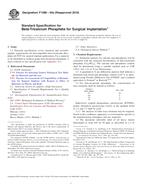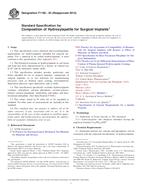Potrebujeme váš súhlas na využitie jednotlivých dát, aby sa vám okrem iného mohli ukazovať informácie týkajúce sa vašich záujmov. Súhlas udelíte kliknutím na tlačidlo „OK“.
ASTM F2193-14
Standard Specifications and Test Methods for Components Used in the Surgical Fixation of the Spinal Skeletal System
Automaticky preložený názov:
Štandardné špecifikácie a skúšobné metódy pre komponenty používané na chirurgické fixácie chrbtice kostrového systému
NORMA vydaná dňa 1.10.2014
Informácie o norme:
Označenie normy: ASTM F2193-14
Poznámka: NEPLATNÁ
Dátum vydania normy: 1.10.2014
Kód tovaru: NS-53133
Počet strán: 14
Približná hmotnosť: 42 g (0.09 libier)
Krajina: Americká technická norma
Kategória: Technické normy ASTM
Kategórie - podobné normy:
Anotácia textu normy ASTM F2193-14 :
Keywords:
bend testing&ndash,plate, bend testing&ndash,rod, bend testing&ndash,screw, bend testing&ndash,surgical implants, fatigue test&ndash,plate, fatigue test&ndash,rod, fatigue test&ndash,screw, fatigue test&ndash,surgical implants, orthopedic medical device&ndash,plate, orthopedic medical device&ndash,rod, orthopedic medical device&ndash,screw, orthopedic spinal devices, performance, spinal arthrodesis, surgical devices, terminology, test methods&ndash,surgical implants
Doplňujúce informácie
| Significance and Use | ||||||||||||||||||||||||||||||||||||||||||||||||||
|
4.1 Spinal implant constructs are typically a compilation of several components. Screws, plates, and rods are integral components of many spinal implant constructs. These components are designed to transfer load between the bone and the longitudinal or transverse element, or both. These specifications and test methods identify specifications for such components and define standard equivalent test methods that can be used when evaluating different related component designs. 4.2 Since the loading of spinal components 4.3 The performance-related mechanical characteristics determined by these specifications and test methods will supply the user with information that may be used to predict the mechanical performance of different design variations of similar (function and indication) spinal construct components. |
||||||||||||||||||||||||||||||||||||||||||||||||||
| 1. Scope | ||||||||||||||||||||||||||||||||||||||||||||||||||
|
1.1 These specifications and test methods are intended to provide a comprehensive reference for the components of systems used in the surgical fixation of the spinal skeletal system. The document catalogs standard specifications that specify material, labeling, and handling requirements. The specifications and test methods also establish common terminology that can be used to describe the size and other physical characteristics of spinal components and performance definitions related to the performance of spinal components. Additionally, the specifications and test methods establish performance requirements and standard test methods to consistently measure performance-related mechanical characteristics of spinal components. 1.2 These specifications and test methods are part of a series of standards addressing systems used in the surgical fixation of the spinal skeletal system. These specifications and test methods concentrate on the individual components, which are found in many spinal fixation systems. If the user is interested in evaluating the next level in the spinal fixation system chain, the interconnections between individual components and subassemblies (two or more components), the user should consult Guide F1798. At the highest level in this chain is Test Methods F1717, which is used to evaluate an entire construct assembled from many components and involves numerous interconnections and several subassemblies. 1.3 It is not the intention of these specifications and test methods to define levels of performance or case-specific clinical performance for spinal components addressed by this document. Insufficient knowledge to predict the consequences of using any of these components in individual patients for specific activities of daily living is available. Furthermore, it is not the intention of this document to describe or specify specific designs for the individual components of systems used in the surgical internal fixation of the spinal skeletal system. 1.4 These specifications and test methods may not be appropriate for all types of spinal surgical fixation systems. The user is cautioned to consider the appropriateness of this document in view of the particular implant system and its potential application. 1.5 This document includes the following specifications and test methods that are used in determining the spinal component's mechanical performance characteristics: 1.5.1 Specification for Metallic Spinal Screws—Annex A1. 1.5.2 Specification for Metallic Spinal Plates—Annex A2. 1.5.3 Specification for Metallic Spinal Rods—Annex A3. 1.5.4 Test Method for Measuring the Static and Fatigue Bending Strength of Metallic Spinal Screws—Annex A4. 1.6 Unless otherwise indicated, the values stated in SI units shall be regarded as the standard. 1.7 This standard may involve hazardous materials, operations, and equipment. This standard does not purport to address all of the safety concerns, if any, associated with its use. It is the responsibility of the user of this standard to establish appropriate safety and health practices and determine the applicability of regulatory limitations prior to use. |
||||||||||||||||||||||||||||||||||||||||||||||||||
| 2. Referenced Documents | ||||||||||||||||||||||||||||||||||||||||||||||||||
|
Podobné normy:
Historická
1.5.2008
Historická
1.9.2010
Historická
1.12.2012
Historická
1.4.2009
Historická
1.3.2014
Historická
15.5.2014



 ASTM F1058-08
ASTM F1058-08 ASTM F1088-04a(2010)..
ASTM F1088-04a(2010).. ASTM F1091-12
ASTM F1091-12 ASTM F1108-04(2009)..
ASTM F1108-04(2009).. ASTM F1185-03(2014)..
ASTM F1185-03(2014).. ASTM F1223-14
ASTM F1223-14
 Cookies
Cookies
